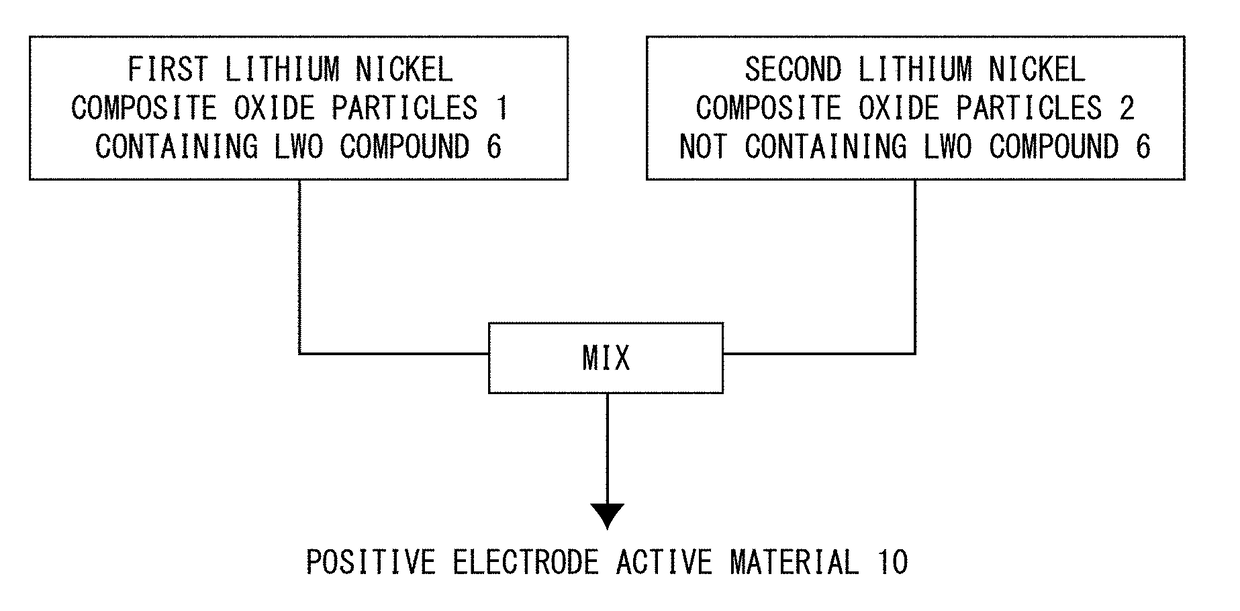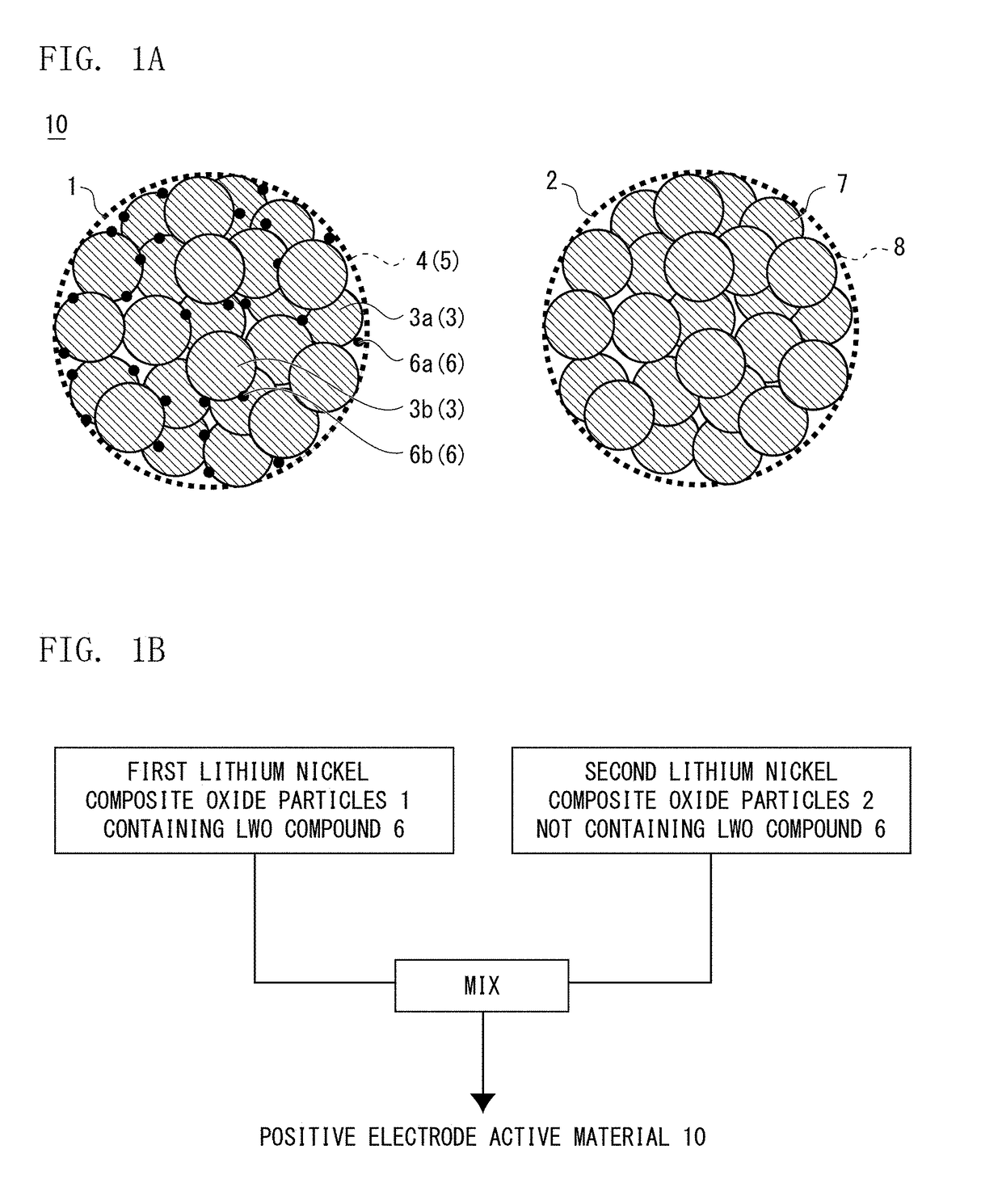Positive electrode active material for nonaqueous electrolyte secondary battery, method for producing the same, and nonaqueous electrolyte secondary battery
a nonaqueous electrolyte and active material technology, applied in the direction of active material electrodes, positive electrodes, cell components, etc., can solve the problems of deteriorating battery characteristics, battery capacity or cycle characteristics, battery characteristics, etc., to reduce the amount of tungsten, high capacity, and high output energy
- Summary
- Abstract
- Description
- Claims
- Application Information
AI Technical Summary
Benefits of technology
Problems solved by technology
Method used
Image
Examples
example 1
[Production of Positive Electrode Active Material]
(Production of First Composite Oxide Particles)
[0157]Powder of lithium nickel composite oxide particles represented by Li1.020Ni0.91Co0.06Al0.03O2 obtained by mixing lithium hydroxide and oxide mainly containing Ni and firing the mixture according to a known technique was used as the base material. To 500 g of the base material, 500 mL of pure water at a temperature of 25° C. was added and slurry was formed. The slurry was stirred for 15 minutes and then water-washing was performed. The water-washed slurry was filtered using a Nutsche to be separated into the solid and the liquid. The obtained washed cake contained water by 8.5% by mass.
[0158]Tungsten oxide (WO3) was added by 3.58 g to the washed cake so that the amount of tungsten became 0.30 at % relative to the total number of atoms of Ni, Co, and Al contained in the base material, and the mixture was mixed sufficiently using a shaker mixer (TURBULA Type T2C, manufactured by Willy...
example 2
[0166]A tungsten mixture was obtained by performing the mixing sufficiently using a shaker mixer device (TURBULA Type T2C, manufactured by Willy A. Bachofen (WAB)) in a manner similar to Example 1 except that 5.37 g of tungsten oxide (WO3) was added to the washed cake so that the amount of tungsten relative to the total number of atoms of Ni, Co, and Al contained in the lithium nickel composite oxide (base material) became 0.45 at %.
[0167]The obtained mixture was put into an aluminum bag and purged with a nitrogen gas, and then laminated. The mixture was put into a drier heated to 80° C. for about an hour. After the heating, the mixture was taken out of the aluminum bag and then placed into a SUS container. Next, the mixture was dried for 10 hours in the stationary state using a vacuum drier heated to 190° C., and then cooled in a furnace.
[0168]The obtained dried tungsten mixture was pulverized with a sieve with a mesh of 38 μm, and the lithium nickel composite oxide particles (firs...
example 3
[0170]A tungsten mixture was obtained by performing the mixing sufficiently using a shaker mixer device (TURBULA Type T2C, manufactured by Willy A. Bachofen (WAB)) in a manner similar to Example 1 except that 8.98 g of tungsten oxide (WO3) was added to the washed cake so that the amount of tungsten relative to the total number of atoms of Ni, Co, and Al contained in the lithium nickel composite oxide (base material) became 0.75 at %.
[0171]The obtained mixture was put into an aluminum bag and purged with a nitrogen gas, and then laminated. The mixture was put into a drier heated to 80° C. for about an hour. After the heating, the mixture was taken out of the aluminum bag and then placed into a SUS container. Next, the mixture was dried for 10 hours in the stationary state using a vacuum drier heated to 190° C., and then cooled in a furnace.
[0172]The obtained dried tungsten mixture was pulverized with a sieve with a mesh of 38 μm, and the lithium nickel composite oxide (first composit...
PUM
| Property | Measurement | Unit |
|---|---|---|
| concentration | aaaaa | aaaaa |
| concentration | aaaaa | aaaaa |
| particle diameter | aaaaa | aaaaa |
Abstract
Description
Claims
Application Information
 Login to View More
Login to View More - R&D
- Intellectual Property
- Life Sciences
- Materials
- Tech Scout
- Unparalleled Data Quality
- Higher Quality Content
- 60% Fewer Hallucinations
Browse by: Latest US Patents, China's latest patents, Technical Efficacy Thesaurus, Application Domain, Technology Topic, Popular Technical Reports.
© 2025 PatSnap. All rights reserved.Legal|Privacy policy|Modern Slavery Act Transparency Statement|Sitemap|About US| Contact US: help@patsnap.com



